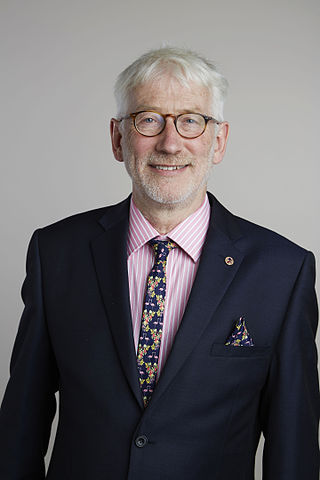
Christian Monyk is the head of the quantum cryptography business unit of ARC Seibersdorf research GmbH. In addition, he is the overall coordinator of Secure Communication based on Quantum Cryptography. [1]

Christian Monyk is the head of the quantum cryptography business unit of ARC Seibersdorf research GmbH. In addition, he is the overall coordinator of Secure Communication based on Quantum Cryptography. [1]
In cryptography, key size or key length refers to the number of bits in a key used by a cryptographic algorithm.

In cryptography, encryption is the process of encoding information. This process converts the original representation of the information, known as plaintext, into an alternative form known as ciphertext. Ideally, only authorized parties can decipher a ciphertext back to plaintext and access the original information. Encryption does not itself prevent interference but denies the intelligible content to a would-be interceptor.

Public-key cryptography, or asymmetric cryptography, is the field of cryptographic systems that use pairs of related keys. Each key pair consists of a public key and a corresponding private key. Key pairs are generated with cryptographic algorithms based on mathematical problems termed one-way functions. Security of public-key cryptography depends on keeping the private key secret; the public key can be openly distributed without compromising security.

A quantum computer is a computer that takes advantage of quantum mechanical phenomena.

Quantum information is the information of the state of a quantum system. It is the basic entity of study in quantum information theory, and can be manipulated using quantum information processing techniques. Quantum information refers to both the technical definition in terms of Von Neumann entropy and the general computational term.
Quantum key distribution (QKD) is a secure communication method that implements a cryptographic protocol involving components of quantum mechanics. It enables two parties to produce a shared random secret key known only to them, which then can be used to encrypt and decrypt messages. The process of quantum key distribution is not to be confused with quantum cryptography, as it is the best-known example of a quantum-cryptographic task.

Symmetric-key algorithms are algorithms for cryptography that use the same cryptographic keys for both the encryption of plaintext and the decryption of ciphertext. The keys may be identical, or there may be a simple transformation to go between the two keys. The keys, in practice, represent a shared secret between two or more parties that can be used to maintain a private information link. The requirement that both parties have access to the secret key is one of the main drawbacks of symmetric-key encryption, in comparison to public-key encryption. However, symmetric-key encryption algorithms are usually better for bulk encryption. With exception of the one-time pad they have a smaller key size, which means less storage space and faster transmission. Due to this, asymmetric-key encryption is often used to exchange the secret key for symmetric-key encryption.

Theoretical computer science (TCS) is a subset of general computer science and mathematics that focuses on mathematical aspects of computer science such as the theory of computation, formal language theory, the lambda calculus and type theory.
In cryptography, a secure channel is a means of data transmission that is resistant to overhearing and tampering. A confidential channel is a means of data transmission that is resistant to overhearing, or eavesdropping, but not necessarily resistant to tampering. An authentic channel is a means of data transmission that is resistant to tampering but not necessarily resistant to overhearing.
Quantum information science is a field that combines the principles of quantum mechanics with information theory to study the processing, analysis, and transmission of information. It covers both theoretical and experimental aspects of quantum physics, including the limits of what can be achieved with quantum information. The term quantum information theory is sometimes used, but it does not include experimental research and can be confused with a subfield of quantum information science that deals with the processing of quantum information.

Artur Konrad Ekert is a British-Polish professor of quantum physics at the Mathematical Institute, University of Oxford, professorial fellow in quantum physics and cryptography at Merton College, Oxford, Lee Kong Chian Centennial Professor at the National University of Singapore and the founding director of the Centre for Quantum Technologies (CQT). His research interests extend over most aspects of information processing in quantum-mechanical systems, with a focus on quantum communication and quantum computation. He is best known as one of the pioneers of quantum cryptography.

Charles Henry Bennett is a physicist, information theorist and IBM Fellow at IBM Research. Bennett's recent work at IBM has concentrated on a re-examination of the physical basis of information, applying quantum physics to the problems surrounding information exchange. He has played a major role in elucidating the interconnections between physics and information, particularly in the realm of quantum computation, but also in cellular automata and reversible computing. He discovered, with Gilles Brassard, the concept of quantum cryptography and is one of the founding fathers of modern quantum information theory.

Gilles Brassard, is a faculty member of the Université de Montréal, where he has been a Full Professor since 1988 and Canada Research Chair since 2001.

John G. Rarity is professor of optical communication systems in the department of electrical and electronic engineering at the University of Bristol, a post he has held since 1 January 2003. He is an international expert on quantum optics, quantum cryptography and quantum communication using single photons and entanglement. Rarity is a member of the Quantum Computation and Information group and quantum photonics at the University of Bristol.
BB84 is a quantum key distribution scheme developed by Charles Bennett and Gilles Brassard in 1984. It is the first quantum cryptography protocol. The protocol is provably secure assuming a perfect implementation, relying on two conditions: (1) the quantum property that information gain is only possible at the expense of disturbing the signal if the two states one is trying to distinguish are not orthogonal ; and (2) the existence of an authenticated public classical channel. It is usually explained as a method of securely communicating a private key from one party to another for use in one-time pad encryption. The proof of BB84 depends on a perfect implementation. Side channel attacks exist, taking advantage of non-quantum sources of information. Since this information is non-quantum, it can be intercepted without measuring or cloning quantum particles.
Post-quantum cryptography (PQC) is the development of cryptographic algorithms that are thought to be secure against a cryptanalytic attack by a quantum computer. The problem with currently popular algorithms is that their security relies on one of three hard mathematical problems: the integer factorization problem, the discrete logarithm problem or the elliptic-curve discrete logarithm problem. All of these problems could be easily solved on a sufficiently powerful quantum computer running Shor's algorithm or even faster and less demanding alternatives.
The Centre for Quantum Technologies (CQT) in Singapore is a Research Centre of Excellence hosted by the National University of Singapore. The Centre brings together physicists, computer scientists and engineers to do basic research on quantum physics and to build devices based on quantum phenomena. Experts in quantum technologies are applying their discoveries in computing, communications and sensing.
Quantum cryptography is the science of exploiting quantum mechanical properties to perform cryptographic tasks. The best known example of quantum cryptography is quantum key distribution, which offers an information-theoretically secure solution to the key exchange problem. The advantage of quantum cryptography lies in the fact that it allows the completion of various cryptographic tasks that are proven or conjectured to be impossible using only classical communication. For example, it is impossible to copy data encoded in a quantum state. If one attempts to read the encoded data, the quantum state will be changed due to wave function collapse. This could be used to detect eavesdropping in quantum key distribution (QKD).
Consider two remote players, connected by a channel, that don't trust each other. The problem of them agreeing on a random bit by exchanging messages over this channel, without relying on any trusted third party, is called the coin flipping problem in cryptography. Quantum coin flipping uses the principles of quantum mechanics to encrypt messages for secure communication. It is a cryptographic primitive which can be used to construct more complex and useful cryptographic protocols, e.g. Quantum Byzantine agreement.

Aditi Sen De is an Indian scientist, a professor in quantum information and computation group at the Harish-Chandra Research Institute, Allahabad. She was born on 1st October 1974 in Kolkata, India. She is known for her research on quantum information and computation, quantum communication including quantum cryptography, quantum optics and many-body physics. The Council of Scientific and Industrial Research, the apex agency of the Government of India for scientific research, awarded her the Shanti Swarup Bhatnagar Prize for Science and Technology for her contributions to physical sciences in 2018. She is the first female physicist to be given this honour. In 2022, she was elected as a member of Indian Academy of Sciences and Indian National Science Academy.